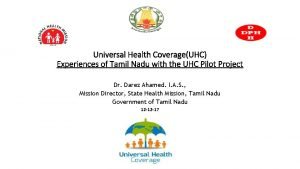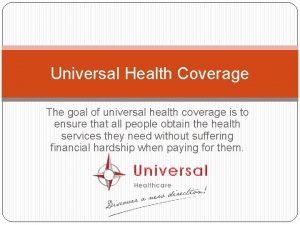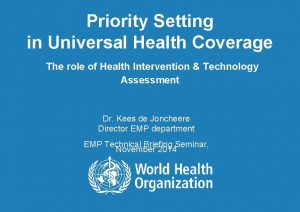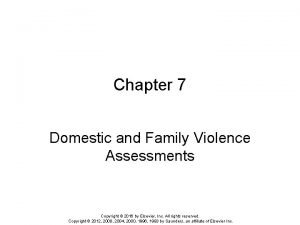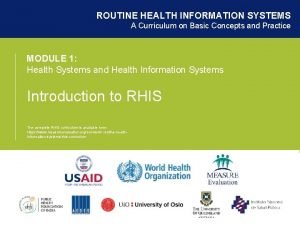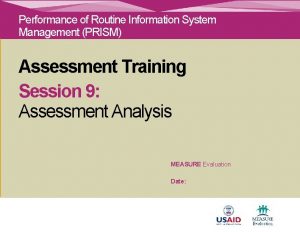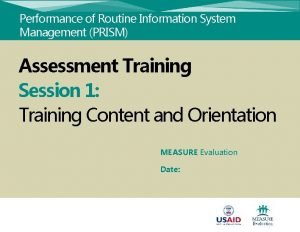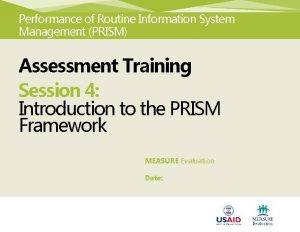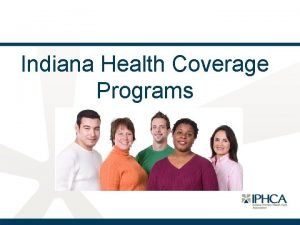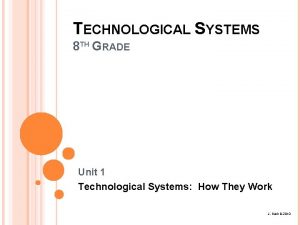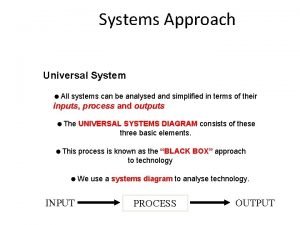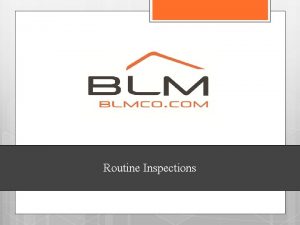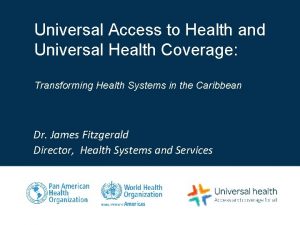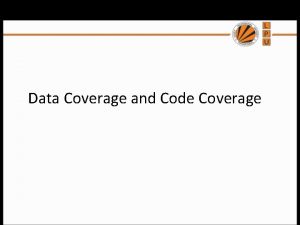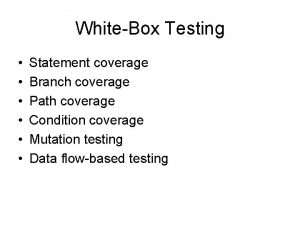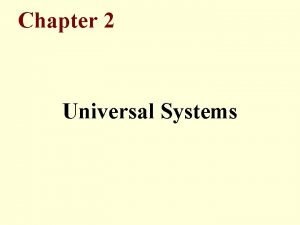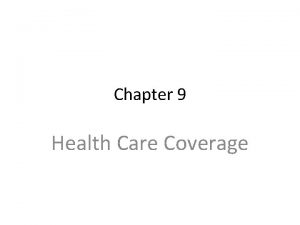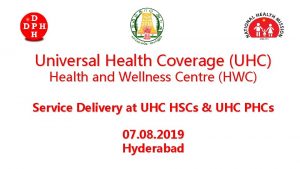Routine Health Information Systems and Universal Health Coverage












- Slides: 12

Routine Health Information Systems and Universal Health Coverage Monitoring in Tanzania Willis Odek, Ph. D Chief of Party/Senior Technical Advisor, MEASURE Evaluation Tanzania The 7 th EAHSC March 27 -29, 2019

Definitions Universal health coverage means that all people have access to the health services they need (prevention, promotion, treatment, rehabilitation and palliative care) without risk of financial hardship when paying for them

Tracking UHC • World Health Organization and World Bank UHC global monitoring framework: • • • health services coverage; financial protection coverage; equity in coverage. • Health service coverage tracer indicators: • • promotion/prevention treatment and care

Routine health information system • Routine health information system refers to any system of data collection, distribution and use that provides information at regular intervals and that is produced through routine mechanisms to address predictable health information needs • Routine health information is usually drawn from data on provision and use of health services. • • clinical service delivery Medicines laboratory services Other diagnostic services Administrative records, Financial Human resource management systems and Quality improvement systems.

Service coverage tracer indicators • • • • • ANC initiation before 12 week gestation ANC 4+ visits Institutional deliveries Skilled birth attendance Need satisfied for family planning DPT 3 immunization coverage Serious acute child illness coverage Household ownership of insecticide treat nets (ITNs) Tuberculosis treatment coverage PMTCT service coverage Contraceptive use Postnatal care within 2 days of birth Diarrhea treated with oral dehydration salts (ORS) Coverage of exclusive breastfeeding Intermittent prevention therapy (IPT) during pregnancy Fever treated with antimalarials Household with indoor residual spraying Tuberculosis case detection rate Male circumcision rates and Condom use at higher risk sex

Service coverage tracer indicators Proportion of deliveries taking place in health facilities 100. 0 95. 0 90. 0 85. 0 80. 0 75. 0 70. 0 Q 1 Q 2 Q 3 Q 4 Q 1 Q 2 Q 3 Q 4 2015 Point estimate 2016 Upper (95% CI) 2017 Lower (95% CI) 2018

Service coverage tracer indicators Proportion of births assisted by skilled attendants 100. 0 80. 0 60. 0 40. 0 20. 0 Q 1 Q 2 Q 3 Q 4 Q 1 Q 2 Q 3 Q 4 2015 Point estimate 2016 Upper (95% CI) 2017 Lower (95% CI) 2018

Service coverage tracer indicators Percentage of pregnant women who start ANC before 12 weeks of gestation age 40. 0 35. 0 30. 0 25. 0 20. 0 15. 0 10. 0 5. 0 0. 0 Q 1 Q 2 Q 3 Q 4 Q 1 Q 2 Q 3 Q 4 2015 Point estimate 2016 Upper (95% CI) 2017 Lower (95% CI) 2018

Service coverage tracer indicators Percentage of pregnant women who received antenatal care 4+ times in a given time period 120. 0 100. 0 80. 0 60. 0 40. 0 20. 0 Q 1 Q 2 Q 3 Q 4 Q 1 Q 2 Q 3 Q 4 2015 Point estimate 2016 Upper (95% CI) 2017 Lower (95% CI) 2018

Challenges to RHIS • Technical - ease of using data collection tools; quality of data • Behavioral - limited knowledge, poor attitudes, lack of value for data • Organizational - information culture, health system structure, roles and responsibilities and resources

Future: RHIS and UHC Monitoring • Continue to strengthen routine health information systems’ capacity • promote use of the data collected at all levels from the service delivery to policy makers levels • harness the potential of digital technologies for data collection and management

This presentation was produced with the support of the United States Agency for International Development (USAID) under the terms of MEASURE Evaluation cooperative agreement AID-OAA-L-14 -00001. MEASURE Evaluation is implemented by the Carolina Population Center, University of North Carolina at Chapel Hill in partnership with ICF International; John Snow, Inc. ; Management Sciences for Health; Palladium; and Tulane University. Views expressed are not necessarily those of USAID or the United States government. www. measureevaluation. org
 Universal health coverage in tamil
Universal health coverage in tamil Universal health care meaning
Universal health care meaning Dimensions of universal health coverage
Dimensions of universal health coverage Routine, universal screening for domestic violence means
Routine, universal screening for domestic violence means Health system building blocks
Health system building blocks Performance of routine information system management
Performance of routine information system management Performance of routine information system management
Performance of routine information system management Performance of routine information system management
Performance of routine information system management Indiana health coverage programs
Indiana health coverage programs Difference between health education and health information
Difference between health education and health information The universal systems model
The universal systems model Universal systems model
Universal systems model Universal systems diagram
Universal systems diagram
